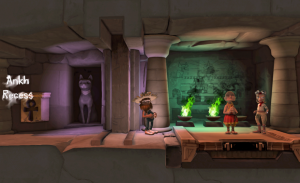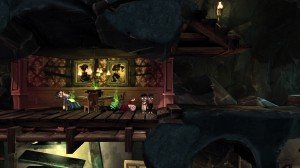
An anthropomorphic, talking cave to explore. Seven oddball characters, each with a twisted back-story. From these, a trio to choose and control: they will jump, grab objects and puzzle their way around obstacles, at your command. Yes, macabre traveler, venture through the stylish gift shop, past the safety disclaimer—waiving legal liability in case of sudden death—and down into the underground labyrinth that is The Cave.
Queue spooky synth music.
 Tim Schafer’s Double-Fine Productions, in association with Sega Games, has another oddball classic on their hands here. A little background: Tim Schafer and others at Double-Fine originally worked for LucasArts, a company renown for releasing top-quality adventure games titles in the ’80s and ’90s like the Monkey Island series, Day of the Tentacle and the ever-stylish Grim Fandango. In 2000, they split from LucasArts and formed Double-Fine, setting up business in an old clog shop, and eventually releasing the platformer cult classic Psychonauts.
Tim Schafer’s Double-Fine Productions, in association with Sega Games, has another oddball classic on their hands here. A little background: Tim Schafer and others at Double-Fine originally worked for LucasArts, a company renown for releasing top-quality adventure games titles in the ’80s and ’90s like the Monkey Island series, Day of the Tentacle and the ever-stylish Grim Fandango. In 2000, they split from LucasArts and formed Double-Fine, setting up business in an old clog shop, and eventually releasing the platformer cult classic Psychonauts.
As a consequence, The Cave is not an immediately definable experience: it is an adventure-puzzler-platformer, although light on the platform elements. Plot development and objectives are revealed through exploration, visual cues, and the smooth-voiced narration from The Cave itself, who provides ominous commentary. In each scenario your actions seem to have … unforeseen consequences, so these sarcastic jibes quickly become routine.
As Mr Sentient Cavern gleefully informs you early on, each available character has a twisted past that will be explored and exploited as you venture below. You can choose from an diverse list, comprised of the Knight, the Adventurer, the Hillbilly, the Monk, the Time-Traveler, the Twins, and the Scientist. All have a special ability: The Adventurer can use a grappling hook; The Knight, arms raised to the sky, has an aura of invulnerability; The Scientist can hack into electronic devices; and so on. Each character’s animation is quite distinct, a favorite being that of The Knight as he runs around with furtive, scarecrow-like movements.
 Much like ‘The Lost Vikings’, the main game mechanic involves combining the talents of your three chosen adventurers to complete mini-quests. One will throw a lever, while the next pressed a button, leading your third character to slide under a lifting gate to reach a prized possession on the other side (possibly the ‘Cursed Guitar’ or, for Monkey Island fans, the ’Can ‘o Grog’). Characters can only hold a single object, which quickly becomes annoying, as in each level only certain characters can reach some important areas and often need to retrieve or collect multiple items at a time. Note: Having an inventory, traditional adventure games do not suffer from this issue.We played through in single-player mode, but there’s also a 2- and 3-player local co-op option that may not have this issue.
Much like ‘The Lost Vikings’, the main game mechanic involves combining the talents of your three chosen adventurers to complete mini-quests. One will throw a lever, while the next pressed a button, leading your third character to slide under a lifting gate to reach a prized possession on the other side (possibly the ‘Cursed Guitar’ or, for Monkey Island fans, the ’Can ‘o Grog’). Characters can only hold a single object, which quickly becomes annoying, as in each level only certain characters can reach some important areas and often need to retrieve or collect multiple items at a time. Note: Having an inventory, traditional adventure games do not suffer from this issue.We played through in single-player mode, but there’s also a 2- and 3-player local co-op option that may not have this issue.
Level design is fluid, starting off in The Cave’s lobby area and then branching off, with your spelunking experience changing depending on character choice. No Hillbilly in your trio? Then, dear player, you wont be visiting the Hillbilly’s Carnival this play-through. Each colorful level is couched in the confines of your underground environment, but the game’s designers have done a great job creating a unique feel to each individual section: The Knight’s Castle is lit by flaming torches, and has an ornate garden, a gleaming sword-in-a-stone, and a sassy princess in a tower; the Time Traveler’s Museum showcases pre-historic creatures, futuristic neon gizmos, and other space-timey junk. Cave paintings, appearing as glowing symbols, are carefully hidden throughout the game and show snapshots of telling moments in the troubled history of each character.
We respect Double-Fine’s commitment to keeping the genre fresh, and nowhere else is that creative ingenuity and planning better displayed than in the names of the interactive and grabbable items your characters interactive with. Much like the the ‘Manual of Style’ and ‘Wax Moose Lips’ from Monkey Island, the ‘Man of Ordinary Strength’ and ‘Spanky the Dog’ are bound to go down in cult adventure game history. Yet, while quirky and fun, at times this creativity does tend to strain the bounds of good humor: various iterations for ‘Fire’ were ‘Flame’, ‘Ouchy-Burny Thing, ‘Flamey-Wamey Thing’, and ‘Frank, The Torch’. Fun, but very cheesy.
Signs feature heavily throughout and are used as great organic storytelling device. A sign proclaiming ‘Cave Tour’, followed by a pointing arrow, will keep your adventurers on the right path. They’re also used to foreshadow future events: a ‘Don’t Forget to Lock & Close Gate’ on the dragon’s den is only briefly considered… until our hero leaves the area. Then we’re treated to the quite realistic sound of a dragon roaring and distant screams.
A snoring dragon, the clanging of The Knight stumbling around in his armor, a the rumble of a shuddering rock face before boulders fall: all are well-chosen sound effects that are used effectively. Ambient synthesizers feature throughout, and present an eclectic mix of moods: the baroque strains of the medieval realm, futuristic sounds from an era yet-to-come, and the haunting tones of the the in-between cave levels all serving to further immerse you. The narrator’s dulcet tones feature heavily and work well to advance the story: in a scene where two of your characters pull levers and cause a rock fall of stepping stones, the narrator sleekly assures us that these actions have consequences, finishing with: ‘I know omens. Trust me, this is omen-ous. Ominous?’ You’ll find yourself, more often than not, sniggering at this constant comedic commentary.
Some of the puzzles were quite difficult, but in a different manner to other adventure titles, where item combinations and using items at the correct time are the focus. In The Cave you instead have to combine player actions—like pulling a lever that opens a drawbridge, while another character sneaks through with a crowbar to pull a crate so another character can eat a sausage—rather than purely focusing on the possibilities of the items themselves in the context of the surrounding environment. The amount of available actions feels small, in contrast with the many permutations of item combinations in traditional adventures. The Cave was obviously influenced by similar Double-Fine titles: with this title they seem to have taken the scope and various objectives of a game like Psychonauts and whittled that concept way, way down to aim at a younger market, and to create a more accessible title. Does the overall gaming experience suffer as a result? Undoubtedly.
Overall, The Cave was stylish yet confusing. The visual effects, sound, music, and comedic asides are all well-crafted elements that do not completely mix together well; a rewarding, whole experience is, disappointingly, lacking. The levels also seemed quite sparse, with only two or three major puzzles in each. Despite this, we’d still recommend a play-through to any avid adventure game or puzzler fan. The quirky humor, unique storytelling style, and replay value make it well worth the journey: so, dig deep, and enjoy the tour.
Rating: 









This review is based on a retail copy of the PC version of The Cave available via Steam, developed by Double-Fine Productions and distributed by Sega Games.



